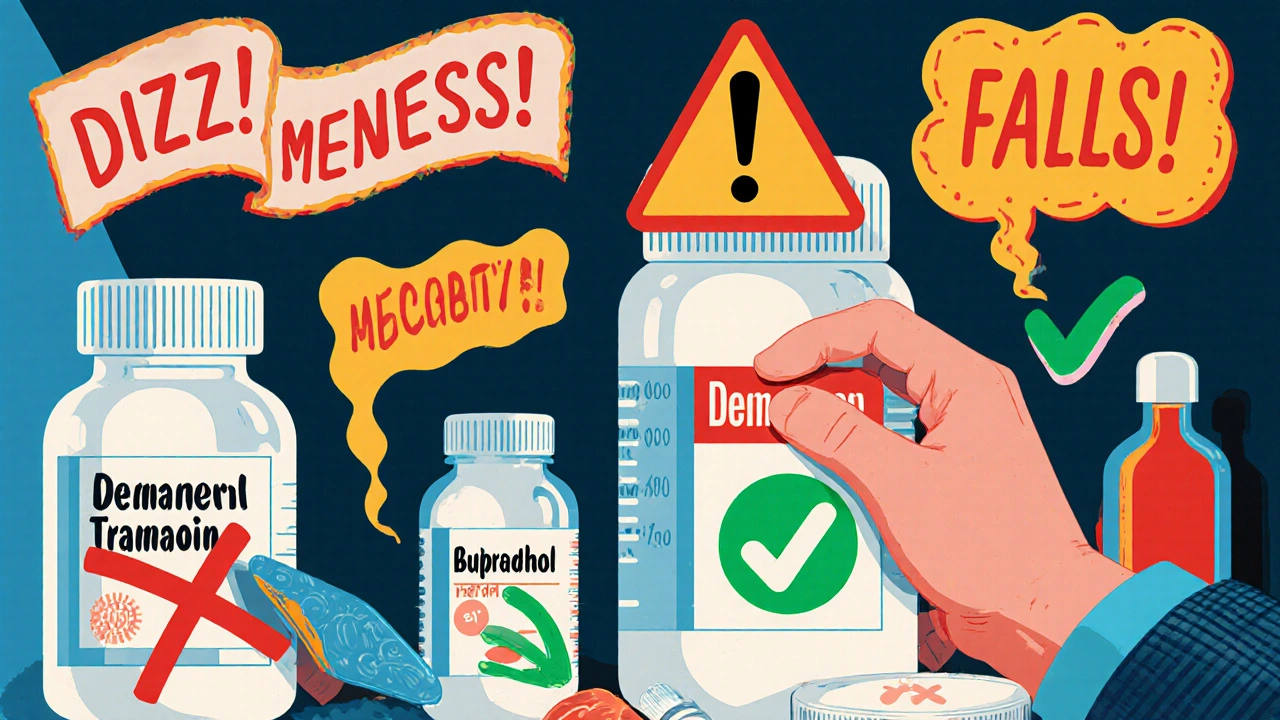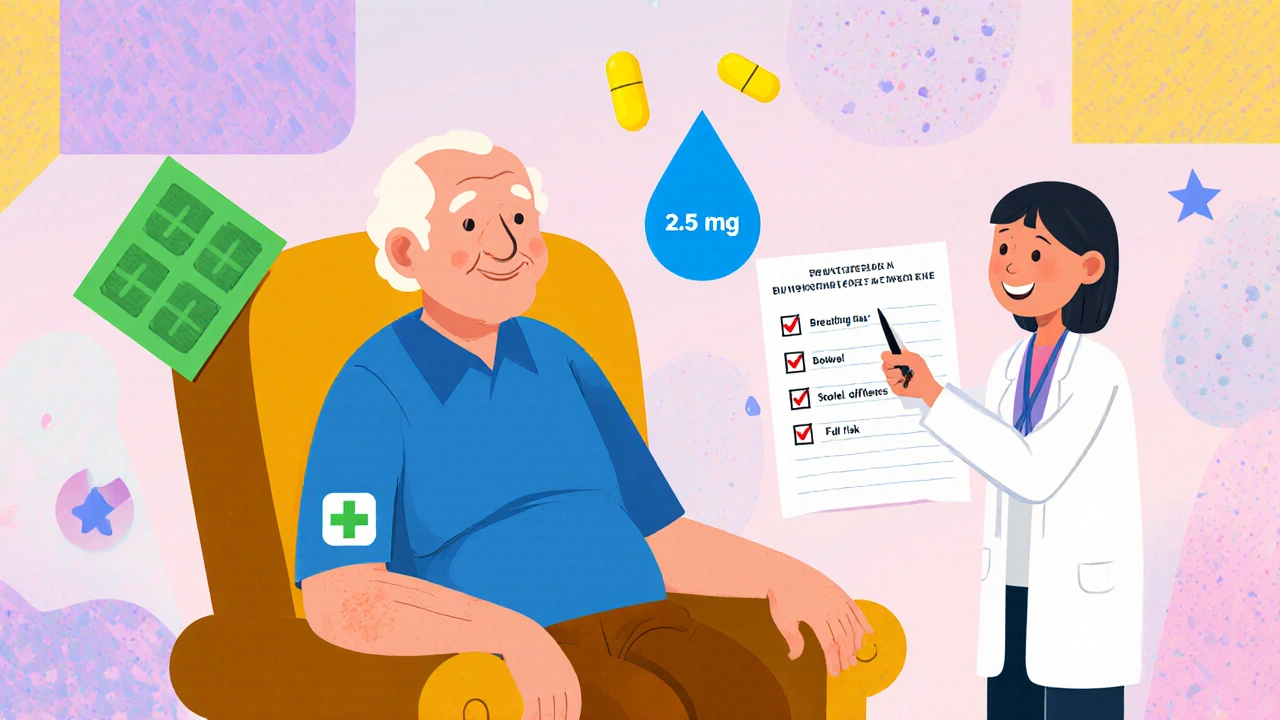When a senior experiences chronic pain-whether from arthritis, nerve damage, or cancer-it’s tempting to reach for opioids. They work. But for people over 65, the risks aren’t just higher-they’re different. What’s safe for a 40-year-old can be dangerous for an 80-year-old. The old rule of thumb-start low, go slow-still applies, but now we know why, and exactly how low and how slow.
Why Seniors React Differently to Opioids
As we age, our bodies change in ways that affect how drugs are processed. Kidneys and liver don’t clear medications as quickly. Body fat increases, while muscle and water decrease. That means opioids stay in the system longer, building up even at normal doses. A 10 mg dose of oxycodone that’s fine for a middle-aged person might cause dizziness, confusion, or breathing trouble in someone over 75.Studies show that seniors are 3 to 5 times more likely to suffer opioid-related side effects like falls, delirium, or constipation. One 2023 study in JAMA Network Open found that after the 2016 CDC guidelines pushed doctors to cut opioid doses, many seniors with cancer ended up on tramadol or gabapentin instead. But those drugs aren’t safer-they cause dizziness and confusion too, and often don’t work as well. The result? More pain, more falls, and more hospital visits.
What Opioids Are Safe for Seniors?
Not all opioids are created equal for older adults. Some should be avoided entirely.- Avoid: Meperidine (Demerol)-its metabolite can cause seizures and delirium. Codeine-converted poorly in many seniors, leading to unpredictable effects. Methadone-long half-life, high risk of dangerous heart rhythms.
- Use with caution: Tramadol and tapentadol-both carry risk of serotonin syndrome if taken with antidepressants, which many seniors are on.
- Preferred options: Oxycodone, morphine, hydromorphone, and especially buprenorphine. Buprenorphine is a partial opioid agonist, meaning it has a ceiling effect: it relieves pain without causing as much respiratory depression or constipation. A 2024 study in the ACOFP Journal found that low-dose transdermal buprenorphine caused no central nervous system side effects when combined with small doses of oxycodone for breakthrough pain.
For seniors who need long-term pain control, transdermal buprenorphine patches are often the best choice. They deliver steady, low-level pain relief without the peaks and crashes of oral pills. And unlike long-acting oxycodone or fentanyl patches, they’re less likely to cause dangerous buildup in the body.
Starting Doses: How Low Is Low Enough?
For someone who has never taken opioids before, the starting dose should be 30-50% of what’s typically prescribed for a younger adult. That means:- Oxycodone: Start with 2.5 mg every 6 hours as needed-not 5 mg or 10 mg.
- Morphine: Start with 7.5 mg every 6 hours-not 15 mg.
- Hydromorphone: Start with 0.5 mg every 6 hours.
Many pharmacies sell 5 mg or 10 mg tablets. Don’t split them. Instead, ask for oral solution (elixir) forms, which allow precise dosing down to 0.1 mg increments. If you’re giving 2.5 mg of oxycodone, that’s half of a 5 mg tablet-or better yet, a 2.5 mg liquid dose.
Never start with long-acting or extended-release pills (like OxyContin or MS Contin) in someone opioid-naïve. These are designed for people already tolerant to opioids. Giving them to someone who’s never taken opioids before can cause fatal respiratory depression within hours.

Dosing Limits and What to Watch For
The American College of Osteopathic Family Physicians defines three opioid dose tiers for seniors:- Low dose: Up to 40 mg morphine equivalents (MME) per day
- Medium dose: 41-90 MME per day
- High dose: Over 90 MME per day
Most seniors should stay in the low-dose range. Even 40 MME is a lot for someone over 80. For context: 40 MME equals 8 tablets of 5 mg oxycodone, or 20 tablets of 10 mg acetaminophen/oxycodone (Percocet). But here’s the catch-Percocet contains acetaminophen. And too much acetaminophen can destroy the liver.
For seniors, especially those over 80 or who drink alcohol regularly, max daily acetaminophen should be 2,000 mg-not 3,000 mg. That means no more than 4 Percocet tablets a day. Many doctors still prescribe 6 tablets, not realizing the risk.
Monitoring: What You Must Track Weekly
Starting opioids isn’t the end of the story-it’s the beginning of close monitoring. Here’s what to check every week for the first month, then every 1-3 months after:- Respiratory rate: Less than 12 breaths per minute while awake is a red flag. Check this at rest, not after exercise.
- Cognitive status: Is the person more confused than usual? Are they forgetting meals, mixing up names, or seeming “out of it”? Delirium from opioids is common and often mistaken for dementia.
- Fall risk: Has the person had a stumble or two? Even minor falls can lead to hip fractures in seniors. Opioids impair balance and reaction time.
- Bowel movements: Constipation is nearly universal. Don’t wait for it to get bad. Start a stool softener (like docusate) and a stimulant laxative (like senna) on day one.
- Pain and function: Is the person walking more? Sleeping better? Eating normally? Pain relief isn’t just about numbers on a scale-it’s about quality of life.
Also, ask: “Are you still taking your other meds the same way?” Many seniors take 5-10 medications. Opioids interact dangerously with benzodiazepines (like lorazepam), sleep aids, antidepressants, and even some antibiotics. A simple drug interaction check can prevent a hospital trip.
When Opioids Aren’t the Answer
Before reaching for opioids, try these first:- Physical therapy: Even 2-3 sessions a week can reduce pain from osteoarthritis by 30-50%.
- Cognitive behavioral therapy (CBT): Helps seniors reframe pain and reduce fear-based avoidance. Proven to work better than placebo for chronic pain.
- Topical NSAIDs: Diclofenac gel applied to knees or hands has minimal absorption into the bloodstream-so it’s much safer than pills.
- Nerve blocks or radiofrequency ablation: For localized pain (like spinal arthritis), these can provide months of relief without drugs.
NSAIDs (like ibuprofen or naproxen) should only be used for short bursts-no more than 1-2 weeks at a time. Long-term use increases risk of stomach bleeding, kidney failure, and heart problems, especially in seniors.
The Bigger Picture: Learning From Past Mistakes
In 2016, the CDC released guidelines meant to reduce opioid overuse. But they were applied too broadly. Doctors stopped prescribing opioids to seniors with cancer, thinking they were following the rules. That was a mistake. For cancer-related pain, opioids remain the most effective option. Studies show a 75% response rate, with an average 50% drop in pain intensity.The 2022 CDC update corrected this. It now says: “Do not apply rigid dose limits to patients with cancer, palliative care, or end-of-life needs.” Professional groups like the American Society of Clinical Oncology and the National Comprehensive Cancer Network never stopped recommending opioids for cancer pain.
The lesson? Guidelines are tools-not rules. Every senior is different. One person may need 20 MME to walk again. Another may get dizzy on 5 MME. The goal isn’t to minimize opioids. It’s to maximize function while minimizing harm.
What Families Should Do
If you’re caring for an older relative on opioids:- Keep a daily log: Pain level (0-10), mood, sleep, bowel movements, any falls.
- Know the exact dose and timing. Don’t assume the pharmacy labeled it right.
- Ask the doctor: “What’s our goal? To reduce pain by 50%? To help them sleep? To walk to the bathroom alone?”
- Never stop opioids suddenly. Tapering must be slow-over weeks or months-or withdrawal can trigger delirium.
- Ask for a medication review every 6 months. Many seniors are on drugs that no longer help-or that are now dangerous.
Seniors deserve to live without constant pain. But they also deserve to live without the hidden dangers of poorly managed opioids. The key isn’t avoiding opioids-it’s using them wisely, with eyes wide open.


